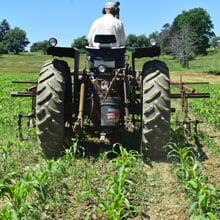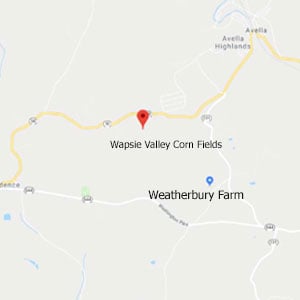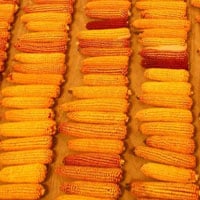Weatherbury Farm Grain Tracker
From Planting to Harvest, Wapsie Valley Corn (Cornmeal and Polenta) in the field:
Plowing and Harrowing (harrowing smooths the field after plowing) the seed bed for the corn.
Planting the Wapsie Valley Corn
26 days after planting. Cultivating the corn.
8 days later, the corn is ready for a 2nd cultivation.
Because we are certified organic we do not use glyphosate (which you may know as RoundUp) to keep the weeds down in the corn field. Instead we cultivate the corn.
The corn after cultivation: the weeds between the rows are gone — without the use of chemicals.
Of course, you can see that growing organically, requires much more time in the field than growing corn conventionally.
This is the day we picked the corn for the display at the county fair.
Cornmeal and Polenta in the field!
Organic triumphs once more at the 2022 Washington County Fair.
Weatherbury’s Wapsie Valley Corn stalks placed 1st — beating all the GMO corn in the county!
This was the fourth year our stalks placed 1st — repeating their victories of 2021, 2017 and 2016.
The corn is beginning to dry down. Corn for milling into polenta and cornmeal is harvested when it is completely dry.
We use our 1980 Gleaner Combine to harvest all of our grains and beans. In between crops, the grain bin on the combine is thoroughly cleaned out and settings are adjusted as necessary for the next crop.
You might ask why we use a 1980 combine. Smaller combines like ours have not been available for sale in the US since 1986 (although they are in Europe). This means we spend more time in the shop most years with our combine than in the field. Just a fact of life in the rolling hills of southwest PA.
Here you see Nigel on day 3 completing some repairs to get the combine back in the field — which as always took longer than expected.
When we pick seed corn, our object is to choose corn that will grow on the heartiest stalks possible .
The farmers look for plants where the corn ears hang lower on the stalk, the stalks are bigger diameter and have brace roots (2nd tier roots) which help to stabilize the corn stalk. We also select ears that point downward as they shed water.
The deer harvested over half our corn for us. Unfortunately, they kept it for their own use.
We harvested the remainder with our Gleaner Combine. The “Combine” is named because It combines four separate harvesting operations—reaping, threshing, gathering, and winnowing—into a single process. Combine harvesters are one of the most economically important labor-saving inventions, significantly reducing the fraction of the population engaged in agriculture. (If you discount maintenance time.)
While the corn is being combined, it is stored in the bin on the combine. Periodically, the corn is unloaded into a gravity wagon. Three sides of the wagon are slanted at about 45 degrees, which makes unloading the wagon easier — as it flows by gravity.
The carbon footprint of all our milled products is tiny because we grow the grains on our farm (as opposed to purchasing them from North Dakota as many small mills do). Our corn travels two miles from the field were it was grown to our mill.
Wapsie Valley Corn Facts 2022
In 2022, Wapsie Valley Corn was grown in Independence Township on the farm established by Robert Leggett in 1815. Leggett had holdings totally 585 acres in the area and raised 1000 sheep. In addition to being a farmer, he was a breeder and dealer of 1st class Spanish sheep (Merino). Today the farm still raises sheep. Weatherbury Farm transitioned this land from conventional in 2013 and it was certified organic in 2015.
The corn was planted on five fields totaling 7.8 acres on May 26, 2022 .
In a “normal” year, we rotary hoe the corn twice and cultivate it twice. Due to rain, we didn’t have the opportunity to rotary hoe the corn but we did cultivate it twice.
The Wapsie Valley Corn was harvested on November 8,2022.
At the 2021 Washington County Fair, Weatherbury’s Wapsie Valley Corn stalks placed 1st — beating all the GMO corn in the county! This was the fourth year our stalks placed 1st — repeating their victories of 2021, 2017 and 2016. The corn ears also won first place and the jar of corn won 2nd place.
And as to taste — cornbread made with Weatherbury’s cornmeal and pastry flour won 2nd place in 2022. The cornbread has placed at the county fair 7 out of the past 8 years (four 1st place and three 2nd place).
For an illustrated explanation of how Weatherbury grains become flour, visit the from seed to flour page.
About Wapsie Valley Corn
Wapsie Valley Corn is an open-pollinated heirloom dent corn dating back to the 1850s. It produces ears of either all coppery red or all dark yellow kernels.
Corn is a spring planted crop. Because Weatherbury Farm is organic, we rotary hoe and cultivate the corn to lessen the impact of weeds.
Products Milled from Wapsie Valley Corn
Polenta and cornmeal are both milled from Wapsie Valley corn, which has both a visual and flavor punch.
During the past eight years, cornbread made with Weatherbury’s cornmeal and sifted pastry flour has won four first place ribbons and three second places at the county fair.
Health Benefits of Corn
Corn is a rich source of vitamins A,B,E and minerals (phosphorus, magnesium, manganese, zinc, iron and copper). With a high fiber content, it plays a significant role in preventing digestive ailments. It is rich in phytochemicals which provides protection against a number of chronic diseases, such as Alzheimer’s.
More Information
You can order cornmeal and polenta either for our monthly on-farm pickup or you can have your order sent to you.
To read more about polenta and cornmeal, please visit our products page.
More information on corn and other grains grown at Weatherbury Farm are on the grains we grow page.
















